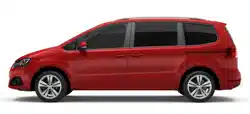Loading ...
Loading ...
Loading ...

Driving
virtual standstill. You can continue to steer the
v
ehicl
e even when the brakes are on full.
Keep your foot on the brake pedal and do not
pump the brakes. You will feel the brake pedal
pulsate while the ABS is working.
If the running gear or brake system is modi-
fied, the effectiveness of the ABS could be se-
verely limited.
Hydraulic Brake Assist (HBA)
The brake assist system can reduce the re-
quired braking distance. The braking force is
automatically boosted if you press the brake
pedal quickly in an emergency. You must
keep pressing the brake pedal until the dan-
ger has passed.
Traction control system (ASR)
In the event of wheelspin, the traction control
system reduces the engine torque to match
the amount of grip available. This helps the
car to start moving, accelerate or climb a
gradient.
Electronic differential lock (EDL)
When the EDL detects wheelspin, it brakes
the spinning wheel and directs the power to
the other driven wheel. This function is active
up to approximately 100 km/h (62 mph).
To prevent the disc brake of the braked wheel
from overheating, the EDL cuts out automati-
cally if subjected to excessive loads. The ve-
hicle can still be driven. The EDL will switch on
again automatically when the brake has
cooled down.
Electronic engine torque management
(XDS)
When taking a curve, the driveshaft differen-
tial allows the outer wheel to turn at a higher
speed than the inner wheel. In this way, the
wheel that is turning faster (outer wheel) re-
ceives less drive torque than the inner wheel.
This may mean that in certain situations the
torque delivered to the inner wheel is too
high, causing the wheels to spin. On the other
hand, the outer wheel is receiving a lower
drive torque than it could transmit. This can
cause a loss of grip on the drive axle, in this
case the front axle, which results in under-
steer or “lengthening” of the trajectory.
The XDS can detect and correct this effect
via the sensors and signals of the ESC.
Via the ESC, the XDS will brake the inside
wheel and counter the excess driving torque
of that wheel. This means that the requested
trajectory is much more precise.
XDS works in combination with the ESC and is
always active, even when ASR is disconnec-
ted, or when the ESC is in Sport mode or dis-
connected.
WARNING
Driving at high speed on icy, slippery wet
ground can r
esult in loss of vehicle control
and serious injury to the driver and passen-
gers.
●
The ESC, ABS, ASR, EDS and the electron-
ic torque control system cannot exceed the
limits imposed by the laws of physics. Al-
ways bear this in mind, especially on wet or
slippery roads. If you notice the systems
cutting in, you should reduce your speed
immediately to suit the road and traffic
conditions. Do not be encouraged to take
risks by the presence of more safety sys-
tems. If you do, an accident may occur.
●
Please remember that the accident risk
always increases if you drive fast, espe-
cially in corners or on a slippery road, or if
you follow too close behind the vehicle in
front of you. The ESC, ABS, brake assist,
EDS and the electronic torque control sys-
tem cannot prevent accidents: risk of acci-
dents!
●
Accelerate with caution on slippery sur-
faces (for example, icy or snow-covered).
Despite the control systems, the driven
wheels could spin, affecting the stability of
the vehicle: risk of accident!
WARNING
The effectiveness of ESC can be consider-
ably reduced if other components and sys-
t
ems affecting driving dynamics are not
288
Loading ...
Loading ...
Loading ...
